For my birthday a couple months back, I went longbox diving for random things that are not available digitally, not least because I could then write posts about them here. This is one of those things.
THE BOOK: Essential Punisher Volume 2, a massive black-and-white phonebook sized reprinting of the first twenty issues of the 1987 Punisher ongoing series, along with Annual #1 and Daredevil #357.
THE CREATORS: Written primarily by Mike Baron; the murderer’s row of art teams includes Klaus Janson, David Ross & Kevin Nowlan, David Ross & John Beatty, Whilce Portacio & Scott Williams, Larry Stroman & Randy Emberlin, and Shea Anton Pensa & Gerry Talaoc; and lettering is primarily by the underrated Ken Bruzenak, with occasional issues from Bill Oakley, Jim Novak, and the immortal Tom Orzechowski. The one exception to all of the above is the Daredevil issue, which is written by Ann Nocenti, drawn by John Romita, Jr. & Al Williamson, and lettered by Joe Rosen.
THE CONCEPT: On the heels of a successful 1986 miniseries that turned Frank Castle from an intermittent guest-starring vigilante into a super-popular antihero, Marvel made the logical business decision of launching an ongoing solo book. This could’ve gone in any number of directions, as the character was still remarkably inchoate. What writer Mike Baron appears to have largely settled on is an overt, conscious attempt at catching the spirit of the era’s action movies. But instead of making Castle a quippy Stallone or Schwarzenegger type, Baron channels the zeitgeisty weirdness behind Bernie Goetz’s 1984 vigilante subway shooting and the Punisher’s ’70s-era Charles Bronson-ish roots. And then he tries to find a way to sustain it indefinitely.
The result is basically the entire “Action” shelf from a circa-1987 Erol’s video store pureed into a fine paste and extruded as a comic book.
The first five issues of the book lean the hardest on 70’s grit, which is perhaps inevitable when Klaus Janson—fresh off the wild success of the self-consciously grimdark urbanism of The Dark Knight Returns—is providing the art. Castle starts off by tackling the drug trade in New York City, then follows it to its source in Bolivia. From there he tries to take a break and winds up fighting white supremacists (sounding depressingly contemporary, to be honest) in Missouri. Janson wraps with two issues of the Punisher vs. a fundamentalist movement led by a charismatic maybe-mutant called The Rev, thus completing a quick initial tour of America’s bogeymen circa 1987: drugs, racists, and crooked fundamentalists (but maybe also just regular fundamentalists too, who really knows).
Janson leaves the book and is replaced for two issues by David Ross. Ross has been a journeyman mainstream comic artist for three decades now, doing solid but largely unremarkable work on a whole bunch of things. If you’re reading this, you’ve probably read a book that he’s drawn, whether you know it or not. In his two-issue stint here, he’s inked by two wildly disparate people, which has the odd knock-on effect of making it obvious just how loose his pencils must be. Because issue #7, inked by John Beatty, looks an awful lot like Mike Zeck (who was frequently inked by Beatty). And issue #6, inked by Kevin Nowlan, looks an awful lot like Kevin Nowlan, and it is glorious.
(Almost glorious enough to overcome the stereotypical 1980’s Arab terrorist villains, armed with a bucket full of plutonium, that the Punisher dispatches here. That’s two more then-current bogeymen dealt with: terrorists, especially when wearing fezes, and nuclear annihilation.)
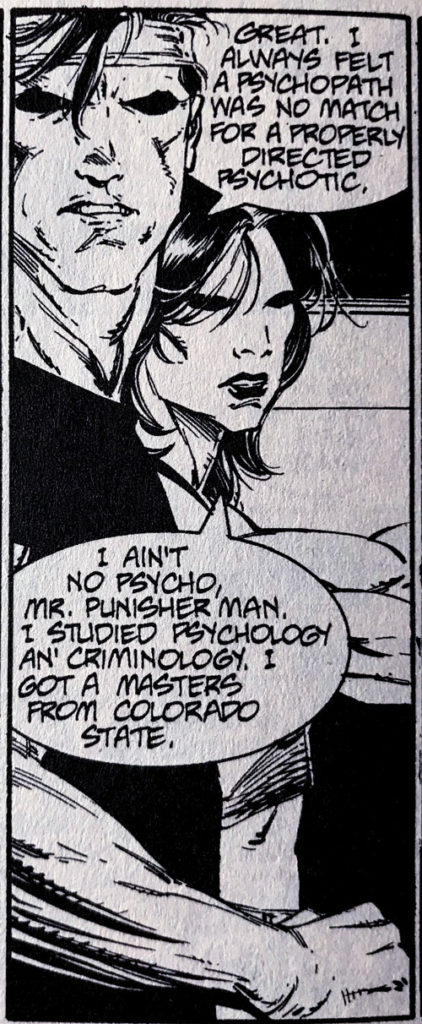 Whilce Portacio and Scott Williams come on as the regular art team just in time for the Punisher to fight the most feared 1980’s scourge of all: ninjas. (Kind of. Ninja-esque dudes in masks with swords, anyway.)
Whilce Portacio and Scott Williams come on as the regular art team just in time for the Punisher to fight the most feared 1980’s scourge of all: ninjas. (Kind of. Ninja-esque dudes in masks with swords, anyway.)
(The era-specific terror that’s ACTUALLY being addressed here is, of course, the menace of Japanese business; see also Die Hard, Rising Sun, and lord knows what-all else.)
This is also just about the point where someone—Baron, or the editor, or Marvel corporate—decides that Frank Castle needs to be a little more tied into the Marvel Universe. First he fights—and crosses over with—Daredevil, and it is the ur-text for every “YOU’RE A KILLER, FRANK! JUSTICE AND CATHOLICISM!” argument those two have had since.
Then, spinning out of a storyline that sends Frank Castle undercover as a substitute teacher (probably inspired by Jim Belushi’s The Principal, although it’s also echoed pretty hard in Tom Berenger’s The Substitute, which it predates by a few years), Castle winds up assembling a team to take down the Kingpin. (The Kingpin is…funding terrorists to…blow up an inner city school…because…reasons, I guess?)
The Punisher’s squad could not be stocked with more 1980s action movie archetypes if it was actively trying: the black guy is another teacher at the school (and would probably be played by Carl Weathers, although it owes a debt to Lou Gossett Jr.’s character in The Principal); the Latina woman is the widow of a mercenary who got killed on a mission with Castle (Maria Conchita Alonso, duh); there’s the punk kid who brings a gun to school but really wants to learn (Christian Slater, maybe?); and Punisher (Dolph Lundgren, of course) and Microchip (George Wendt, I guess?).
This six issue story-arc is probably the most out-and-out fun to be had in this book, even if almost everyone in the story dies, generally alone and horribly. But, hey, that’s how it goes for the racially diverse supporting cast in an eighties action movie! Just ask the dudes in Predator. (Also, between the Daredevil story and this one, Frank Castle also manages to kill a not-at-all-thinly-veiled Charles Manson, because if there is one actual, human-ish face to the bogeyman of the 20th century, it’s probably got a swastika carved between its eyes.)
Portacio departs after the Kingpin arc—unless I’m forgetting the timeline completely, he’s heading off to the far greener pastures of the X-Men books—and the last two issues collected here feel like inventory stories at best: guest artists, including an all-but-unrecognizable Larry Stroman, done-in-one plots, and a general wheel-spinning feeling of meaninglessness.
This is also unquestionably the most problematic-in-hindsight portion of this often-problematic collection, as the final story has the Punisher killing a man who spends the entire story dressed as a woman. It’s played as a Hitchcockian WHO COULDA PREDICTED IT twist, but it feels hellaciously unpleasant as the final story in a collection whose throughline has been, as I keep noting, the Punisher killing the things people feared in the eighties. (The issue before it features the Punisher going to Australia to kill people, because Crocodile Dundee also haunted the eighties.)
It’s an unfortunate, unpleasant note to end on, but the book was spinning wildly off the rails at this point in its publication history. It was the classic Marvel recipe for disaster, flooding the market with titles without sufficient story to fill them, long after the character’s popularity had begun to wane. After this, the Punisher would fight lots of ninjas and Dr. Doom, before the book started to descend into total insanity, and this stupid, ill-advised, nasty-in-hindsight issue feels like the start of that plummet.
What this volume represents, then, is the one sustained stretch of true novelty for the Punisher as a solo character. Even if only as a historical artifact, it’s a fascinating read.
WHAT WORKS:
- The art, first and foremost. The black & white treatment in the Essential volumes can be unfortunate for some of the more brightly colored heroes, but it works perfectly for the Punisher, thematically, and for most of the artists here, visually. Janson in particular shines in this format, where he can be the pulp artist he was always meant to be.
- And Kevin Nowlan, man (even if just inking over Dave Ross). That guy doesn’t draw nearly enough comics. He’s really good. (In fact, his one issue of the book was the first one I bought as a kid, and served as my introduction to the character—the Mike Mignola cover was eye-catching enough to make me finally check out the hype on this character. And the combo of Mignola/Nowlan’s cover Punisher and the Ross/Nowlan one inside pretty much spoiled me for all Punisher artists for a long time.)
- Even Whilce Portacio’s muscles-on-muscles and lines-on-lines style has a vibrant, kinetic energy that holds up, and his love of shadows and deep, inky blacks plays well on the cheap newsprint paper.
- Baron’s scripts are enjoyable as well, as long as you know what you’re in for. His dialogue is stilted, his plots are willfully (almost gleefully) derivative, and his humor is sardonic and deadpan and frequently ill-placed. His Frank Castle is a broken man, emotionally, completely cold inside—the scene where he delivers Microchip’s son’s body to an unsuspecting Microchip with a terse “I’m sorry, man…” is genuinely bone-chilling in Castle’s abject lack of emotion—but he’s got a lot of the hard-bitten gumshoe in him, too. Castle puts on a lot of disguises in this book, and has more sex than you’d expect as well. The modern Frank Castle has been distilled into a more mythic form—Garth Ennis’s take, mainly, crystallizing into the One True Punisher, Avatar of Vengeance—but this is a looser, dirtier version, and it’s interesting to watch Baron trying to figure out how best to use him.
- The assault on the Kingpin arc holds up remarkably well—I think I enjoyed that story without needing any relativist thinking or ironic detachment. It’s not going to open eyes or change minds, but if you want a solid Punisher story you could do a whole lot worse.
- Viewed purely as a time capsule from the distant decade of the 80’s, this book works really well. With the possible exception of that Kingpin arc, this book is inextricably tied to the 1980s, and that really works in its favor. The guys at the We Hate Movies podcast have a theory that any Friday the 13th or Nightmare on Elm Street reboot would need to be a period piece, because those stories are inherently OF the 1980s, and I came away from this book feeling the same way about the Punisher.
- I’m the farthest thing in the world from a gun fetishist, but there’s something in this book’s meticulous attention to detail in weaponry that helps it. This is the era when Eliot Brown would provide incredibly detailed schematics for the Punisher’s weapons in “Punisher’s Armory” text pages (which, in hindsight, are creepy as all hell), and you can feel that kind of research and reference material throughout. And that also plays into the eighties aesthetic, because it’s like a Tom Clancy book with pictures, from a firearm-porn standpoint.
- Y’know what else holds up unfortunately well? The horror of the white supremacists the Punisher kills in issue #4. Their rhetoric, their hatred…it all feels depressingly contemporary, and is an awful reminder of how little some things have changed in the intervening three decades. (That said, the moment where the Punisher burns the guy alive and cracks a joke about Southern-fried colonels has a bit of Nazi-punching catharsis to it, if I’m being totally honest.) It’s also impressive how much Baron just straight-up GOES THERE. It’s nice to see a fictitious fascist piece of garbage be allowed to really sound like a genuine racist asshole.
WHAT DOESN’T:
- If you don’t look at it as deliberately shallow, and as a product of its era, this book is problematic as hell. The bad guys are almost all thinly-drawn stereotypes; the social politics are often terrible; the violence is somehow abjured and glorified all at the same time. For some reason when I read it, I was able to set those things aside—or, more accurately, see in hindsight how problematic they clearly were, and how ignorant I was about so many things. (I was also ten when I read the first of these issues, so I can forgive myself a bit for not understanding at the time.) In a world where it sometimes seems like the worst parts of the eighties are suddenly relevant again (Donald Trump! Fear of nuclear disaster! Conflict with Russia!), I wonder if there’s not something instructive in revisiting all of this stuff, but it’s not a read that’s going to be for everyone, and I certainly don’t blame anyone who would rather just not engage with it at all.
SHOULD IT BE ONLINE: Yeah, it probably should. It’s formative work on one of Marvel’s most popular characters, featuring (if nothing else) some great art that deserves to be appreciated. But what it really should be is available as a series of cheap little B&W paperbacks, like graphic novel equivalents to The Executioner books. That’s the level it’s operating at, and that’s the packaging in which I think it should probably be preserved.
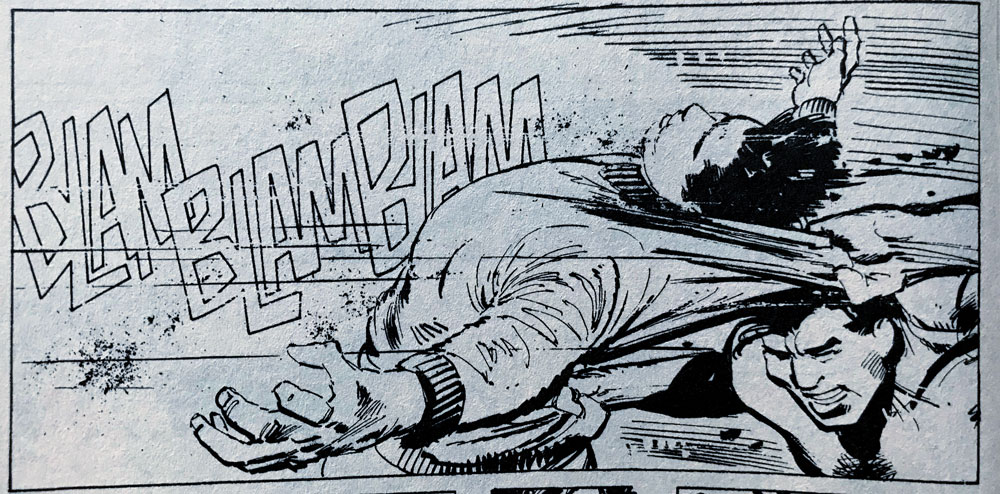
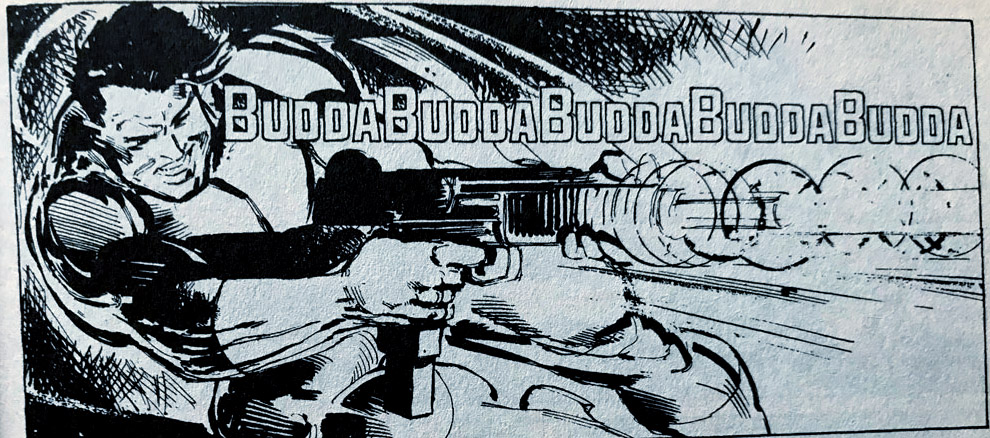

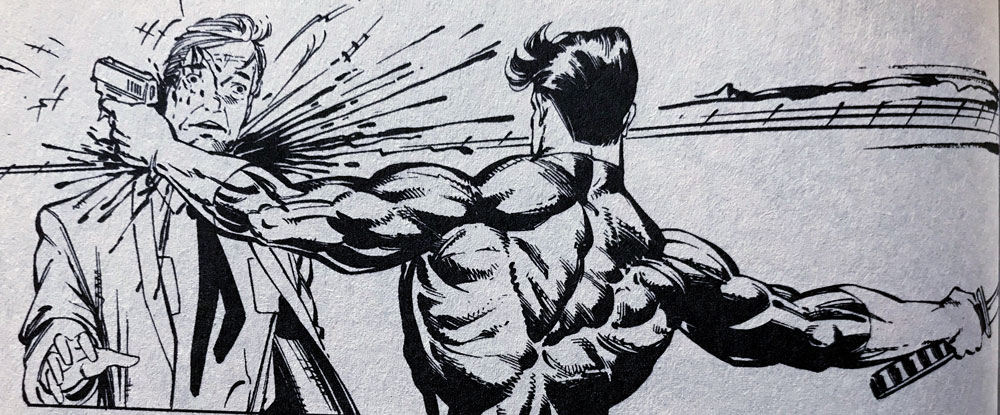
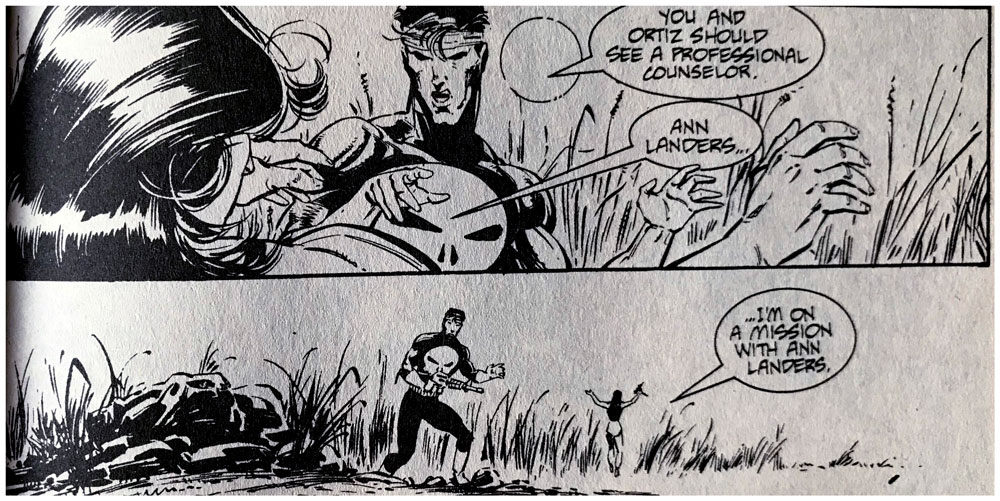


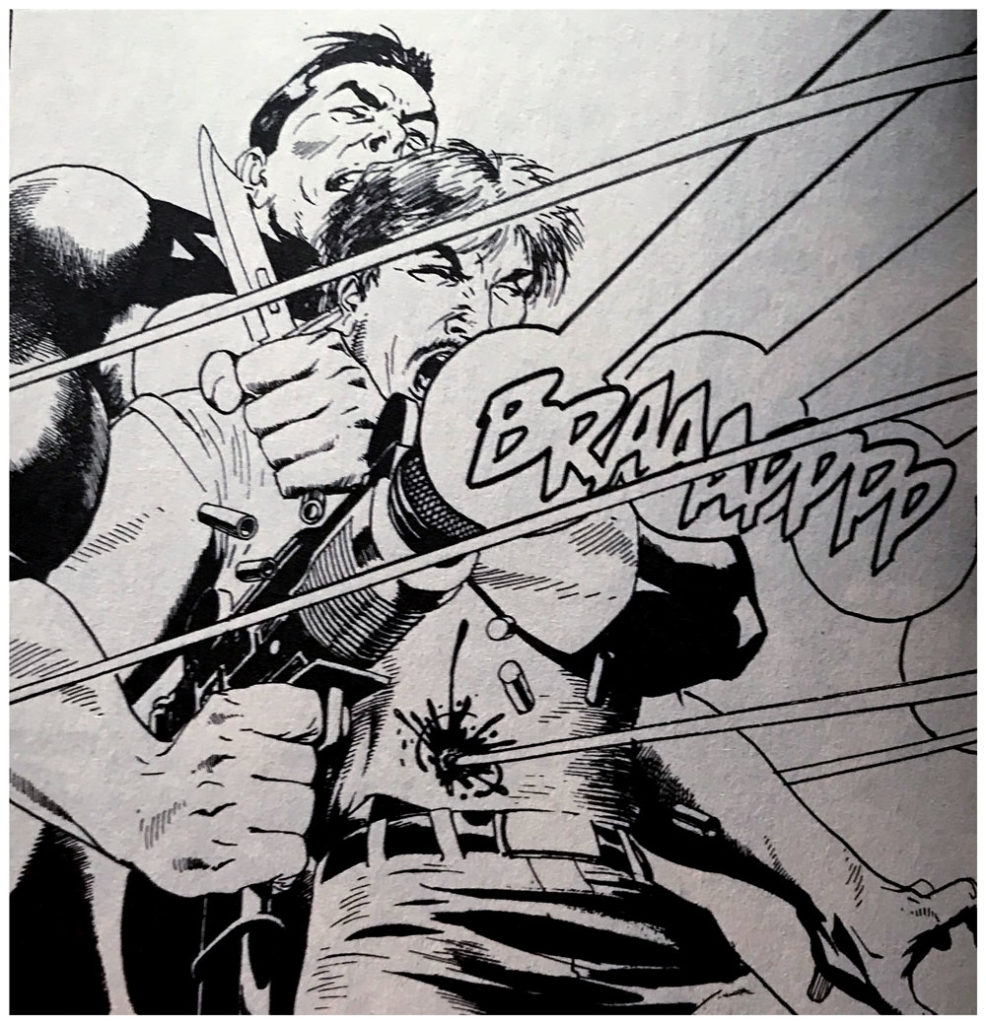


Janson’s art looks good in black and white but you should really check out the color versions. He actually did the coloring for his issues as well. It’s a great effect because you get Janson-eque marks in a variety of colors. I think those five issues are some of the nicest looking Marvel comics ever published.
I tend to agree. To me, this era of Punisher works as a combination of all different kinds of action movies of the era. You can enjoy it if you don’t take it too seriously. By comparison, I found Garth Ennis’s stuff to be very uncomfortable because it felt like glorification of the Punisher that went too far. I don’t think the writing in these stories are necessarily well-written, but it was good for what it is.